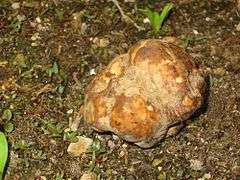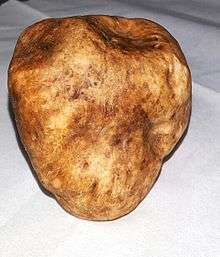Terfeziaceae
The Terfeziaceae, or desert truffles, is a family of truffles (Berber: Tirfas, Arabic: كمء Kam') endemic to arid and semi-arid areas of the Mediterranean Region, North Africa, and the Middle East, where they live in ectomycorrhizal association with Helianthemum species and other ectomycorrhizal plants (including Cistus, oaks, and pines). This group consists of three genera: Terfezia, Tirmania, and Mattirolomyces. They are a few centimetres across and weigh from 30 to 300 grams (1–10 oz). Desert truffles are often used as a culinary ingredient.
| Terfeziaceae or Terfess | |
|---|---|
 | |
| Desert truffle (Terfezia spp.) from Avanos, Turkey | |
| Scientific classification | |
| Kingdom: | |
| Division: | |
| Subphylum: | |
| Class: | |
| Order: | |
| Family: | Terfeziaceae |
| Genera | |
|
Terfezia | |
Family description
Fruit-bodies (ascomata) are large, more or less spherical to turbinate (like a top), thick-walled, and solid. The asci are formed in marbled veins interspersed with sterile tissue. The asci are cylindrical to spherical, indehiscent (not splitting open at maturity), and sometimes stain blue in iodine. Ascospores are hyaline to pale brown, spherical, and uninucleate.[1]
Habitat and ecology
Desert truffles, as the name suggests, predominantly grow in the desert. They have been found in arid and semi-arid zones of the Kalahari desert, the Mediterranean basin, Turkey, Syria, Azerbaijan, Iran, Iraq, Kuwait, the Negev desert in Israel, the Sahara, Saudi Arabia, Qatar, Libya, Spain, Greece, Cyprus, Hungary, Croatia, and China.[2][3] They can be formed near Sunrose plants, but they are very rare to find and can't be cultivated (thus justifying their cost).
Culinary use and commercial importance
Desert truffles do not have the same flavor as European truffles, but tend to be more common and thus more affordable. Forest truffles (genus Tuber) typically cost $1000 per kilogram, and Italian truffles may sell for up to $2,200 per kilogram, while Terfezia truffles sold as of 2002 in Riyadh for $80 to $105 a kilo, and in recent years have reached, but not yet exceeded, $270.[4] Israeli agricultural scientists have been attempting to domesticate Terfezia boudieri into a commercial crop.[5]
Vernacular names
Desert truffles go by several different names. In Iran they are called Donbalan, In Turkey they are called Domalan in Central Anatolia and Keme on the Syrian border. In Algeria and Tunisia they are called terfez, the Bedouin of the Western Desert call them terfas ترفاس. The Kuwaitis call them fagga فقع, the Saudis فقع faq'h, and in Syria, and in Libya terfase ترفاس, they are known by their classical Arabic name, kamaa كمأ. Iraqis call them kamaa, kima or chima كمأ, depending on local dialects and in Oman they arefaqahفقع The Hebrew word is kmehin (kmeha in singular). In southern Spain, they are known as turmas or criadillas and in the Canary Islands they are known as Papas Crias. In Botswana they are called mahupu. In Iran; they are called Dombal. The Nama-Damara call them !Nabas, where they are also known as the "Kalahari truffle". In Hungary they are known as homoki szarvasgomba ("sand truffles") and are sold to English-speaking nations as honey truffles.[6]
In Saudi Arabia, there are two varieties; khalasi are oval with a black skin and a pinkish-ivory interior, and zubaidi have a cream colour but are generally more expensive.
In oceanic countries, there is some confusion regarding the desert truffle, as the yam is often referred to as the common desert truffle as well.[7]
Species list
- Terfezia arenaria
- Terfezia boudieri
- Terfezia claveryi
- Terfezia leptoderma
- Terfezia terfezioides - phylogenetic analyses based on nuclear rDNA sequences strongly suggest that this species be reassigned to the original monotypic genus Mattirolomyces.[8]
- Tirmania nivea
- Tirmania pinoyi
References
| Wikimedia Commons has media related to Terfeziaceae. |
- Cannon, P.F., Kirk, P.M. (2007). Fungal Families of the World. p. 347. Singapore: CABI Publishing. 456 pp.
- Kagan-Zur V. Terfezias, a family of mycorrhizal edible mushrooms for arid zones. In: Schlissel, Arnold; Pasternak, D. (2001). Combating desertification with plants. New York: Kluwer Academic/Plenum Publishers. ISBN 978-0-306-46632-8.
- Loizides, M., Hobart, C., Konstandinides, G., Yiangou, Y. (2012). Desert Truffles: The mysterious jewels of antiquity. Field Mycology 13 (1): 17-21. doi:10.1016/j.fldmyc.2011.12.004
- Feeney, J: Desert Truffles Galore, page 22–27. Saudi Aramco World, 2002.
- Nargi, Lela (2019-07-01). "As Israel's Desert Truffles Become Scarce, a Researcher Works to Grow Them as Crops". Atlas Obscura. Retrieved 2020-04-20.
- "The Hungarian Sweet Truffle". Trufamania.
- Tedder, M. M. Yams, a description of their cultivation on Guadalcanal in the Solomon Islands.(Noumea: South Pacific Commission, 1974) pp. xi
- Percudani, R., Trevisi, A., Zambonelli, A., Ottonello, S. (1999). Molecular phylogeny of truffles (Pezizales: Terfeziaceae, Tuberaceae) derived from nuclear rDNA sequence analysis. Molec. Phylogenet. Evol. 13(1):169-80.
- Dıéz J, Manjón JL, Martin F. (2002) Molecular phylogeny of the mycorrhizal desert truffles (Terfezia and Tirmania), host specificity and edaphic tolerance. Mycologia 94(2): 247–259.
